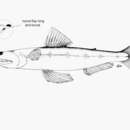Trophic Strategy
provided by Fishbase
Occurs in inshore waters (Ref. 75154).
- Recorder
- Auda Kareen Ortañez
Biology
provided by Fishbase
An uncommon species found in shallow shelf waters. Caught mainly with artisanal gear. Sold fresh or dried salted in markets.
Comprehensive Description
provided by Smithsonian Contributions to Zoology
Synodus sageneus Waite, 1905
Synodus sageneus Waite, 1905:58 [Western Australia].
Xystodus banfieldi Ogilby, 1910:6 [Queensland, Australia].
Xystodus sageneus Whitley, 1943:173.
MATERIAL EXAMINED.—Holotype: WAM P25509-001, Freemantle, WESTERN AUSTRALIA. SRI-LANKA (3): USNM 217618 (1), 217619 (1), FMNH 89077 (1); GULF OF CARPENTERIA (7): AMS I.6140 (1), I.15557-035 (6). Queensland, AUSTRALIA (7): AMS IA.1301 (1), IA.6485 (1), 6486 (1), IA.6691 (1), IA.6794 (1), IA.6824 (1), I.20938-006 (1). NEW GUINEA (1): ANSP 81548.
DIAGNOSIS AND COMPARISONS.—A species of Synodus with the following combination of characters: dorsal-fin rays (branched and unbranched) 12–13 (usually 12); anal-fin rays 12–15 (usually 13); pored lateral-line scales 51–55 (usually 52); transverse scale rows 3.5/5; vertebrae 49–54 (usually 51); combined dorsal and anal procurrent rays 25–29; anterior palatine teeth not longest and not in a discrete group; peritoneal spots 5–6; posterior pelvic process wide; base of anal fin longer than base of dorsal fin.
The greater length of the anal-fin base vs. dorsal-fin base separates this species from all other known Indo-West Pacific Synodus.
DESCRIPTION (holotype plus range).—Dorsal-fin rays 12(12–13); anal-fin rays 15(12–15); pectoral-fin rays 13; pelvic-fin rays 8; procurrent rays 25(25–29), dorsal 13(13-15), anal 12(11–14); lateral line continuous, 52(50–55) pored scales; scale rows above lateral line from dorsal origin 3.5; scale rows below lateral line to anal origin 5; predorsal scales 18; rows of cheek scales 7(6–7); vertebrae 52(49–54); peritoneal spots 5–6.
Percentages of Standard Length: Mean (range): head length 28.9(26.9–29.9); snout length 6.2(5.3–7.1); upper jaw length 18.1(16.0–19.5); diameter of bony orbit 4.4(3.2–6.5); least width of bony interorbital 3.2(2.4–4.0); snout to dorsal origin 44.2(41.2–46.8); snout to adipose origin 86.2(79.4–92.4); snout to anal origin 67.1(62.5–73.1); snout to pelvic insertion 35.8(33.4–40.6); snout to pectoral insertion 27.0(25.5–28.9); first-dorsal-ray length 9.6(7.8–12.3); longest-dorsal-ray length 15.5(13.7–17.7); pectoral-fin length 12.8(10.9–16.4); pelvic-fin length 26.1(23.6–28.4); dorsal-fin base 14.7(12.7–16.1); anal-fin base 18.8(15.8–21.6); based on 16 specimens 41.6 to 232.2 mm SL.
Body fusiform, head somewhat depressed, caudal region a little compressed. Large cycloid scales on body, cheeks, and operculum, postoral portion of cheeks scaly. Snout sharply pointed, broader than long; the anterior nostril on each side bearing a broad flap extending beyond margin of nares when depressed anteriorly. Posterior nares with scalloped edge. Ventral edge of adipose eyelid extended ventrally encircling a suborbital pit, edge of eyelid fimbriate around pit opening. Interorbital space concave, occipital region bony. Palatine teeth in an elongate V-shaped pad, teeth pointing backwardly, those in front not largest and not in a discrete group. Lingual teeth short, not as well developed as in other species, those on free end of tongue largest and about 35 in number. Teeth caniniform, larger teeth with arrow-shaped tips. Pectoral fins not quite reaching a line from base of pelvic fins to origin of dorsal fin. Outer pelvic ray unbranched and short, fifth branched ray (sixth ray) longest. Posterior bony process of pelvic girdle broad. Peritoneum pale.
COLOR PATTERN.—Some preserved specimens with darker dorsum. Faint lateral, poorly defined, diamond-shaped pigment areas with ventral portion extending below lateral line. Waite (1905:59) described the holotype as “yellow above and silvery beneath.” The preserved holotype is now very dark dorsally and ventrally. Specimens from Sri-Lanka have little pigment.
DISTRIBUTION, HABITAT, AND GEOGRAPHIC VARIATION.—This species is known from Sri-Lanka, western Australia (Freemantle), north and northeastern Australia, and Dutch East Indies (Sorong). Collection data indicate that this species is present in waters 12–22 m and caught in prawn trawls (probably not a coral reef inhabitant). The vertebral counts of the Sri-Lanka specimens were higher (53–54) than the Australian and New Guinea material (49–52).
- bibliographic citation
- Cressey, Roger F. 1981. "Revision of Indo- West Pacific lizardfishes of the genus Synodus (Pisces: Synodontidae)." Smithsonian Contributions to Zoology. 1-53. https://doi.org/10.5479/si.00810282.342
Speartoothed grinner: Brief Summary
provided by wikipedia EN
The speartoothed grinner (Synodus sageneus) is a species of lizardfish that lives mainly in the Indo-West Pacific.
- license
- cc-by-sa-3.0
- copyright
- Wikipedia authors and editors

